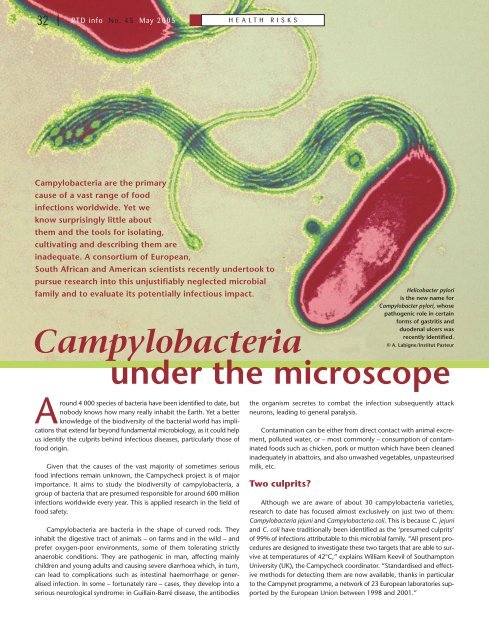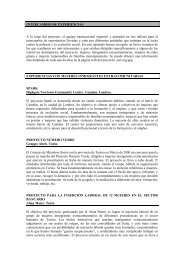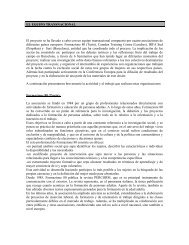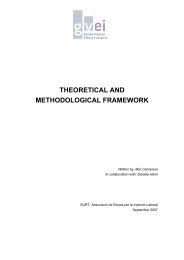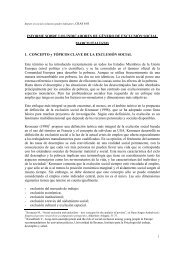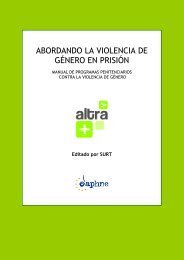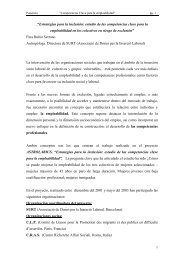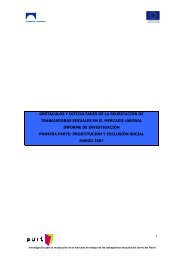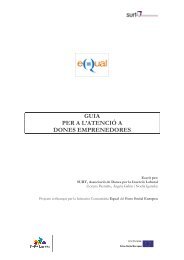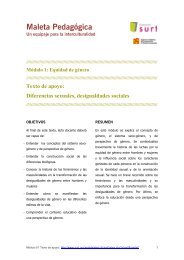32<strong>RTD</strong> <strong>info</strong> No. 45 May <strong>2005</strong>HEALTH RISKSCampylobacteria are the primarycause of a vast range of foodinfections worldwide. Yet weknow surprisingly little aboutthem and the tools for isolating,cultivating and describing them areinadequate. A consortium of European,South African and American scientists recently undertook topursue research into this unjustifiably neglected microbialfamily and to evaluate its potentially infectious impact.Helicobacter pyloriis the new name forCampylobacter pylori, whosepathogenic role in certa<strong>info</strong>rms of gastritis andduodenal ulcers wasrecently identified.Campylobacteriaunder the microscope© A. Labigne/Institut PasteurAround 4 000 species of bacteria have been identified to date, butnobody knows how many really inhabit the Earth. Yet a betterknowledge of the biodiversity of the bacterial world has implicationsthat extend far beyond fundamental microbiology, as it could helpus identify the culprits behind infectious diseases, particularly those offood origin.Given that the causes of the vast majority of sometimes seriousfood infections remain unknown, the Campycheck project is of majorimportance. It aims to study the biodiversity of campylobacteria, agroup of bacteria that are presumed responsible for around 600 millioninfections worldwide every year. This is applied research in the field offood safety.Campylobacteria are bacteria in the shape of curved rods. Theyinhabit the digestive tract of animals – on farms and in the wild – andprefer oxygen-poor environments, some of them tolerating strictlyanaerobic conditions. They are pathogenic in man, affecting mainlychildren and young adults and causing severe diarrhoea which, in turn,can lead to complications such as intestinal haemorrhage or generalisedinfection. In some – fortunately rare – cases, they develop into aserious neurological syndrome: in Guillain-Barré disease, the antibodiesthe organism secretes to combat the infection subsequently attackneurons, leading to general paralysis.Contamination can be either from direct contact with animal excrement,polluted water, or – most commonly – consumption of contaminatedfoods such as chicken, pork or mutton which have been cleanedinadequately in abattoirs, and also unwashed vegetables, unpasteurisedmilk, etc.Two culprits?Although we are aware of about 30 campylobacteria varieties,research to date has focused almost exclusively on just two of them:Campylobacteria jejuni and Campylobacteria coli. This is because C. jejuniand C. coli have traditionally been identified as the ‘presumed culprits’of 99% of infections attributable to this microbial family. “All present proceduresare designed to investigate these two targets that are able to surviveat temperatures of 42°C,” explains William Keevil of SouthamptonUniversity (UK), the Campycheck coordinator. “Standardised and effectivemethods for detecting them are now available, thanks in particularto the Campynet programme, a network of 23 European laboratories supportedby the European Union between 1998 and 2001.”
HEALTH RISKS<strong>RTD</strong> <strong>info</strong> No. 45 May <strong>2005</strong> 33The Campycheck project promoters believe, however, that researchershave been rather too quick to jump to conclusions in identifying the guiltyparties. They take the view that, due to insufficient monitoring, weknow little about the real prevalence of infections caused by campylobacteria.No figures are available for Europe, for example. In the UnitedStates, the Centre for Disease Control in Atlanta reports around 10 000cases a year, about 100 of them proving fatal – but estimates that theactual number of infections annually is around 2 to 4 million, making thisthe main cause of food poisoning, ahead of salmonella!Why is there this discrepancy? “Infections by campylobacteria are generallysporadic and rarely result in epidemics, as a result of which researchon methods of contamination has been rather neglected,” explainsWilliam Keevil. “But there is also a lack of scientific knowledge. Our hypothesisis that there are many campylobacteria species which we are unableto detect. These emerging varieties could be responsible for many illnesseswrongly attributed to C. jejuni and C. coli. So much remains to be donein this field. In particular, we must develop tests able to identify nonthermo-tolerantbacteria.”A transcontinental affairIsolating, describing and detecting these unlisted campylobacteriais essentially the role of Campycheck, an association that includes, in additionto Southampton University, the Irish National FoodAuthority’s laboratory, Cape University (South Africa), the Universityof Bologna (Italy), the Danish Veterinary Institute, andthe US Department of Agriculture, representing three continents.“The aim of the project came from a conversationin the United States with Al Lastovica of Cape University, aworld-renowned specialist on this bacterial family,” explainsWilliam Keevil. “This global research structure is justified bythe fact that the threat posed by campylobacteria, whichcould be carried by migrating birds, really has to beapproached on a planetary basis. This is particularly vital ata time when we are seeing an increase in trade in foodstuffsbetween different continents.”The first task the researchers have set themselves is toacquire new tools with which to explore this largely unknownmicrobial world, such as low-oxygenated culture media,monoclonal antibodies able to detect proteins common toall campylobacteria varieties, and Polymerase Chain Reaction(PCR) kits able to distinguish between species and subspecies.The aim is to develop campylobacteria detection teststhat can be applied in the fields of human medicine (analysisof blood diseases), veterinary medicine (on the basis ofexcrement obtained from farms), and health safety (food or drinking watersamples).The likely economic benefits of this innovative work are illustratedby the presence, as project partners, of two British biotechnology companiesspecialising in microbiological biodiagnostics – Microgen BioproductsLtd (Camberley, Surrey) and Oxoid Ltd (Basingstoke, Hampshire).“Eighteen months after start-up, we have the tools needed to isolateand characterise emerging campylobacteria,” says the coordinator.“A number of US, Asian and European laboratories have contacted us,which shows the interest in the various aspects of our programme.”For health protectionHowever, the Campycheck project extends beyond this research andtechnological development activity. In the field of fundamental microbiology,campylobacteria obtained from the three continents on whichthe programme partners are based (Europe, Africa,North America) will be pooled and analysed genetically.The collection at the Stephen On laboratory atthe Danish Veterinary Institute already containsaround 60 strains and many remain to be describedand classified.Our knowledge of microbial biodiversity, whichis patchy to say the least, will be boosted directly fromthis. But it is in the field of public health that the mostbenefits are expected. In co-operation with the foodTo find out more0 www.campycheck.org0 www.campynet.vetinst.dkContact0 William KeevilC.W.Keevil@soton.ac.uksafety authorities in a number of countries, Campycheck plans to undertakean epidemiological study of the prevalence of campylobacteria at variousstages in the food chain, from ‘farm to fork’. “The project’s ultimateaim is to obtain a risk management model that will make it possible todiscover whether or not new and emerging varieties of campylobacteriacarry a risk on the same scale as C. jejuni,” concludes William Keevil.The intestinal wall formsmultiple folds covered in villi:this picture shows the uppersection (apex) of the absorbentpolygonal cells that constitutethe villi of the small intestine.It is these cells that absorb food.Size: 0.1 mm in diameterper villus.© C.Haffen/InsermIntracellular motility of theShigella bacterium which invadesand destroys the intestinal mucousof the colon, causing diarrhoea.It moves around the infected celland propagates in neighbouringcells by creating a tail ofpolymerised actin.© J.P.Sansonetti/Inserm


